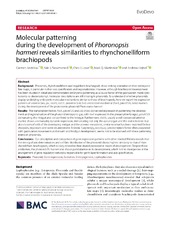| dc.description.abstract | Background: Phoronids, rhynchonelliform and linguliform brachiopods show striking similarities in their embryonic fate maps, in particular in their axis specification and regionalization. However, although brachiopod development has been studied in detail and demonstrated embryonic patterning as a causal factor of the gastrulation mode (protostomy vs deuterostomy), molecular descriptions are still missing in phoronids. To understand whether phoronids display underlying embryonic molecular mechanisms similar to those of brachiopods, here we report the expression patterns of anterior (otx, gsc, six3/6, nk2.1), posterior (cdx, bra) and endomesodermal (foxA, gata4/5/6, twist) markers during the development of the protostomic phoronid Phoronopsis harmeri. Results: The transcription factors foxA, gata4/5/6 and cdx show conserved expression in patterning the development and regionalization of the phoronid embryonic gut, with foxA expressed in the presumptive foregut, gata4/5/6 demarcating the midgut and cdx confined to the hindgut. Furthermore, six3/6, usually a well-conserved anterior marker, shows a remarkably dynamic expression, demarcating not only the apical organ and the oral ectoderm, but also clusters of cells of the developing midgut and the anterior mesoderm, similar to what has been reported for brachiopods, bryozoans and some deuterostome Bilateria. Surprisingly, brachyury, a transcription factor often associated with gastrulation movements and mouth and hindgut development, seems not to be involved with these patterning events in phoronids. Conclusions: Our description and comparison of gene expression patterns with other studied Bilateria reveals that the timing of axis determination and cell fate distribution of the phoronid shows highest similarity to that of rhynchonelliform brachiopods, which is likely related to their shared protostomic mode of development. Despite these similarities, the phoronid Ph. harmeri also shows particularities in its development, which hint to divergences in the arrangement of gene regulatory networks responsible for germ layer formation and axis specification. | en_US |

